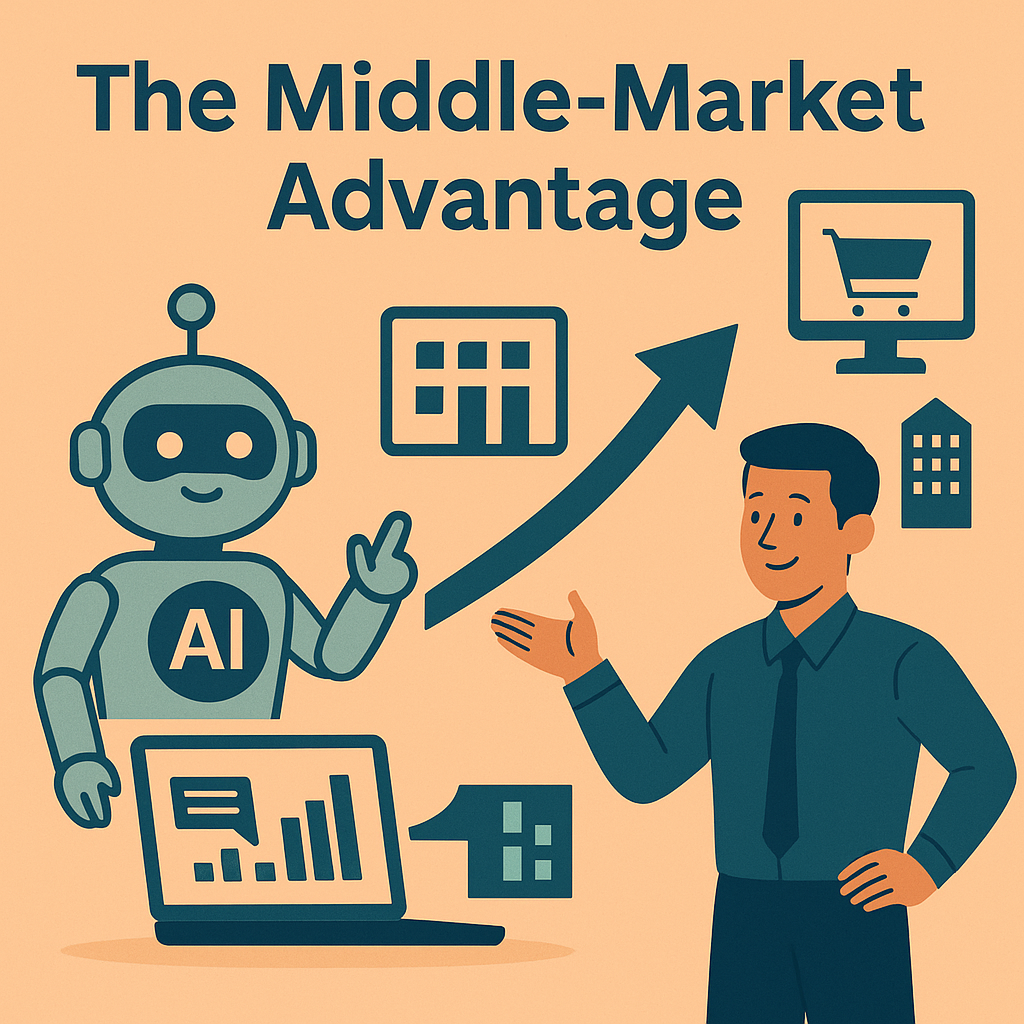For years, artificial intelligence (AI) felt like a luxury reserved for large enterprises with deep pockets. Complex implementations, bespoke systems, and specialist teams made it inaccessible for most mid-sized firms. But that’s no longer true.
In 2025, AI has shifted from an elite tool to an everyday advantage. Thanks to affordable platforms, modular solutions, and subscription pricing, mid-market businesses (20–40 staff) now have the power to compete with enterprise-scale rivals—without enterprise costs.
Why Mid-Market Firms Are Perfectly Placed for AI
Large enterprises often struggle to adopt AI quickly because of bureaucracy, legacy systems, and the sheer complexity of scale. Smaller businesses may lack the resources to invest. Mid-market firms, however, occupy the sweet spot:
- Big enough to feel the pain of inefficiency — duplicated admin, scheduling chaos, compliance overheads.
- Small enough to move quickly — decisions can be made in weeks, not years.
- Hungry enough to compete — they need to punch above their weight against larger rivals.
According to Deloitte, 57% of mid-sized firms adopting AI reported measurable competitive advantage within the first year.
Levelling the Playing Field
Smarter Customer Experience
Enterprises invest millions in customer engagement platforms. Mid-market businesses can now achieve the same outcomes with AI-powered chatbots, automated emails, and personalised recommendations—at a fraction of the cost. Salesforce reports that 69% of customers expect connected experiences, something even a 25-person team can now deliver with the right tools.
Data-Driven Decisions Without a Data Science Team
AI-driven analytics platforms like Zoho Analytics give mid-market firms enterprise-grade insights without needing in-house statisticians. From profitability dashboards to demand forecasting, these tools help leaders make decisions based on facts, not gut feel.
Compliance That Runs Itself
While enterprises hire whole compliance departments, mid-market firms can automate document generation, consent tracking, and audit preparation. PwC notes that automated compliance can halve audit prep time, reducing risk while saving staff hours.
Scalable Operations Without More Staff
AI takes over repetitive processes—invoice generation, courier booking, stock allocation—allowing mid-sized firms to scale revenue without scaling headcount. That’s the true leveller: growth without bloat.
Real-World Example
A 30-staff logistics company faced an enterprise competitor with triple its resources. Instead of trying to outspend them, they invested in AI automation:
- A chatbot handled 60% of customer enquiries.
- Courier tracking bots updated customers automatically.
- Automated invoicing and stock allocation sped up cash flow.
- Reporting dashboards gave leaders real-time insight into margins.
The result? Customer satisfaction rose, admin time fell, and the firm won contracts previously thought “too big” for a company their size.
The Cost Advantage
Here’s the kicker: mid-market firms don’t need multimillion-dollar budgets. Subscription AI tools spread costs, scale with growth, and deliver ROI fast. McKinsey research shows companies adopting AI see productivity gains of 20–30% within the first year. For a mid-sized firm, that can be the difference between surviving and thriving.
Building the Middle-Market AI Roadmap
Success doesn’t come from trying to replicate enterprise systems all at once. Instead, mid-market businesses should take a phased approach:
- Identify high-friction processes — e.g. quoting, invoicing, scheduling.
- Automate customer touchpoints — chatbots, email updates, reminders.
- Integrate analytics — dashboards for cash flow, margins, and forecasting.
- Expand AI into compliance and forecasting — scaling capabilities as confidence grows.
This roadmap allows firms to start small, prove value, and scale without risk.
The Bottom Line
Mid-market businesses don’t need to accept second place to enterprise rivals. With AI, they can deliver enterprise-grade service, insights, and efficiency—without enterprise costs.
By adopting a phased approach, firms with just 20–40 staff can compete head-to-head with much larger competitors. In today’s market, agility is the true advantage—and mid-market firms have it in spades.
The middle market doesn’t just survive the AI revolution. It leads it.

